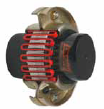The next information and facts is necessary when building a Grid coupling assortment:
Description of motor or engine, the horse electrical power (or KW), and RPM at slowest coupling speed though below load
Description of the driven gear
Shaft and keyway sizes as well as the sort of match for driver and driven products (clearance or interference)**
Shaft separation (BSE)
Bodily space limitations (see Application Worksheet)
Decide what the environmental problems are going to be, this kind of as temperature, corrosive circumstances, interference from surrounding structures, and so on.
By default, sizes 1020 – 1090 will be clearance fit, sizes 1100 – 1200 is going to be interference match.
** Machines all bores and keyways to meet the dimensional and tolerance specs per ANSI/AGMA 9002-B04 for inch bores, or ISO 286-2 for metric bores.
Typical grid couplings consist of two grid hubs, a grid spring, and a cover assembly. When the shaft separation requires a spacer type coupling, the coupling will include two shaft hubs, two spacer hubs, a grid spring, in addition to a horizontal cover assembly.
Formulas Employed To Determine Torque:
Application Torque (in-lbs) = ( horse electrical power x 63025  ) /RPM
) /RPM
Application Torque (Nm) = ( horse power x 9550 ) /RPM
Selection Torque = Application Torque x Service Component
Higher Peak Loads and Brake Applications
For applications where large peak loads or higher braking torques may be existing, the following extra information will probably be required:
System peak torque and frequency
Duty cycle
Brake torque rating
The selection torque formula is just like the formula proven above except the application torque need to be doubled prior to applying the support factor.
Application Torque (in-lbs) = ( horse electrical power x 63025 ) /RPM
Application Torque (Nm) = ( horse electrical power x 9550 ) /RPM
Choice Torque = 2 x Application Torque x Service Factor
Measures In Choosing A Grid Coupling
Phase 1: Establish the application torque working with the formula proven over.
Phase 2: Pick the Support Component from the charts .
For applications not displayed utilize the chart proven to your correct. Establish the Assortment Torque working with the formula proven above.
Stage 3: Making use of the choice torque as calculated, refer to the Performance Chart
Step four: Compare the maximum bore for your size chosen and make sure the expected bore sizes do not exceed the utmost allowable. In case the needed bore size is greater, step up to the following dimension coupling and verify to find out when the bore sizes will match.
Stage five: Applying the chosen coupling size, examine the bore and keyway sizes
Step 6: Speak to your nearby industrial supplier using the component numbers to spot sizes with all the charts for UPC part numbers.